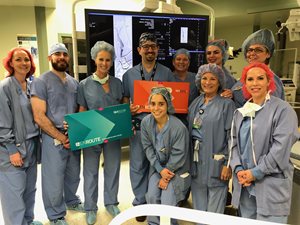For Gerald Surette, being the first patient to try a new procedure was an easy decision. “I’m already undergoing chemotherapy for lymphoma, so when I heard there’s an easier way to treat my clogged arteries without a huge surgery, I said, ‘Why not’!
Catholic Medical Center’s vascular surgeon Toufic Imam, MD, treated Surette’s carotid artery disease using a new procedure called Transcarotid Artery Revascularization (TCAR). TCAR is a clinically proven, minimally invasive and safe approach for patients who need to be treated for carotid artery disease (CAD) but are too high risk for surgery. Given his cancer treatment, Surette was an ideal candidate for the new procedure. He is now at a much lower risk for stroke.
(CAD) is a form of atherosclerosis, or a buildup of plaque, in the two main arteries in the neck that supply oxygen-rich blood to the brain. If left untreated, carotid artery disease often leads to stroke. In fact, it’s estimated that up to a third of all strokes are caused by CAD, with 400,000 new diagnoses of the disease made every year in the U.S. .
“TCAR is a revolutionary new option in the fight against stroke, and is particularly suited for the large portion of patients we see who are at higher medical and surgical risk of complications from carotid surgery due to age, anatomy, or other conditions,” said Dr. Imam. “Because of its low stroke risk and faster patient recovery, I believe TCAR represents the future of carotid repair.”
TCAR is unique in that blood flow is temporarily reversed during the procedure so that any small bits of plaque that may break off in the artery are diverted away from the brain, preventing a stroke from happening. A stent is then placed inside the artery to stabilize the plaque, minimizing the risk of a future stroke. Prior to TCAR, the main treatment option for severe CAD was an open surgical procedure called carotid endarterectomy (CEA). CEA removes plaque from inside the carotid artery to restore normal blood flow to the brain, but the large incision leaves a visible scar and carries risks of surgical complications, including bleeding, infection, heart attack, stroke and nerve injuries.
Surette’s physician, Patricia Furey, MD, Chief of Vascular Surgery assisted during the procedure and said, “It went flawlessly because we have a highly skilled surgeon and vascular surgical team."
“After everything I’ve been through with the cancer, I knew I didn’t want to have a stroke too! I’ve got two great doctors and I’ve lived an extra ten years because of them. And I’ll probably live 10 more now. I feel great.” Surette said.